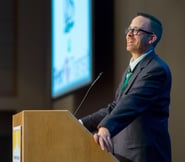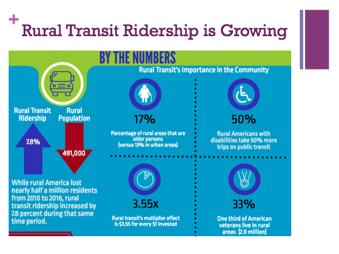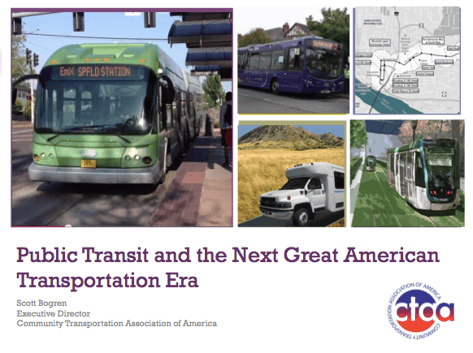http://web1.ctaa.org/webmodules/webarticles/anmviewer.asp?a=23&z=2Community Transportation Association of America Executive Director Scott Bogren has been working with, writing about and covering the community and public transportation industry for nearly three decades. His experience with CTAA includes being Editor-in-Chief of Community Transportation magazine; crafting the Association's various legislative, policy and regulatory positions on Capitol Hill; and shaping CTAA's communications, training and leadership activities.
 Ecolane: Obviously funding is the crux to getting most transportation projects off the ground, many people rely on federal funding. With our current administration, are you seeing any kind of changes with the existing funding structures?
Ecolane: Obviously funding is the crux to getting most transportation projects off the ground, many people rely on federal funding. With our current administration, are you seeing any kind of changes with the existing funding structures?
SB: The current Federal Trust Fund model is not working anymore for our transit agencies. The funding source has remained unchanged for the last 24 years while our costs for transportation projects have gone up. Since these federal funds are competitive and not as reliable anymore, we are seeing more and more transit projects funded by individual states as well as cities passing local tax measures. We are approaching a “fiscal cliff” in 2020. There is “no spare change in the couch” as any funding was swept up in the 2018 tax bill.
Ecolane: Aside from agencies having to get creative with funding, what other changes are you seeing within the transportation industry?
 SB: The transit industry is seeing growth outside of large cities. Even though the rural population has gone down, we’ve seen a 40% increase in rural transit ridership. Of these people 17% are elderly. More than 50% of these people have disabilities and use public transportation. As the older population increases, the demand for reliable transportation also increases. Chronic healthcare conditions are creating a demand for transit agencies. Over 3.6 million Americans either miss or delay healthcare appointments due to transportation. Every day, 10,000 Americans turn 65, EVERY SINGLE DAY FOR THE NEXT 10 Years!
SB: The transit industry is seeing growth outside of large cities. Even though the rural population has gone down, we’ve seen a 40% increase in rural transit ridership. Of these people 17% are elderly. More than 50% of these people have disabilities and use public transportation. As the older population increases, the demand for reliable transportation also increases. Chronic healthcare conditions are creating a demand for transit agencies. Over 3.6 million Americans either miss or delay healthcare appointments due to transportation. Every day, 10,000 Americans turn 65, EVERY SINGLE DAY FOR THE NEXT 10 Years!
Ecolane: How do you think this demand is changing the transit industry?
SB: The demand is changing the face of the industry. The industry is becoming competitive to meet demand. They’re looking at technology and data to effectuate change. Agencies are trying to figure out how they can become more efficient so their customers can make their medical appointments or trips to the grocery stores, etc. We are also looking at Uber and Lyft but traditional transit approaches are still the best with Uber and Lyft only ever achieving 3 rides per hour on occasion, while losing $2.3 Billion and in most cases not meeting the requirements of the ADA.
Ecolane: What kind of emerging trends are you seeing to assist with the recent demand needs?
SB: There have been many innovations in transit that people have been testing. From seeing flex route changes to service re-design focused on frequency of trips. Many agencies have also been working with TNCs to assist with their overflow and also using them as a form of mico-transit. We’ve also seen simplifying fare payment to create a smoother more efficient on-boarding process for clientele. Believe it or not, autonomous vehicles are on the way, but we will see how wide spread their usage will become.
Ecolane: Do you think these trends are the solution for all transit agencies?
SB: No. Transit solutions are not a one size fits all. Networking with other agencies in similar size to see how they’ve overcome internal challenges is necessary. Smaller agencies may find flex routes as a good solution while larger agencies may want to incorporate TNCs. Regardless, in order for agencies to be successful they will need to embrace change and a larger debate on how community transportation is meeting the needs of rural and small urban America. In almost every case, a community transportation provider is a more affordable and better approach than an ambulance or a private dialysis provider. When you combine this with great technology you see a more holistic approach to providing service in this new and changing environment. It will provide flexibility within community transportation operations so they can meet their current demand needs. We are in the business of moving people and in order to provide a value of service we will need to change the way we think.
---
As I sat down to compile the results of the interview with Scott, I was struck by how often he used the terms technology and funding and the huge impact both have on transit. Recently, I attended a Type 1 diabetes management seminar. This seminar focused on treating the disease in a more proactive way using dynamic vs. static approaches. A dynamic approach is reacting in real-time (in many cases, using technology), whereas static practices emphasize following general guidelines and a backward-looking care plan. Like dynamic diabetes care, Scott is advocating a more dynamic approach to transit delivery and with the fiscal cliff approaching, we cannot continue to deliver service in the same manner as before using outdated, manual scheduling tools.
Check out the Explainer video and the Mobile App video to learn more about the dynamic vs. static scheduling discussion!
About the Author
Ryan Larsen
Read Ryan's blog articles for perspective, opinion and information on transit and paratransit issues.
%20(200%20x%20100%20px).png)

